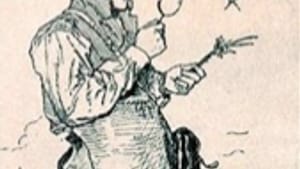Stay in the Loop
BSR publishes on a weekly schedule, with an email newsletter every Wednesday and Thursday morning. There’s no paywall, and subscribing is always free.
A journey in a hiccupping time machine
Sharon White's "Vanished Gardens'

As Sharon White walks through Philadelphia's neighborhoods, she contemplates not only what's here, but what used to be here. In a series of impressionistic chapters, she explores William Penn's "greene countrie towne" as it is now, still green with parks and street trees, community gardens and empty lots. But White also explores the territory beneath that surface: the lost 18th- and 19th-century estates and gardens, the paths of the Lenni-Lenape, the underlying geology.
In Vanished Gardens, White names each chapter after a different plant, using it as a touchstone while she mixes history with accounts of her walks, her encounters with neighbors and strangers, her daily activities, her memories and musings.
The chapter titled, "Elm," for example, opens on a spring morning as the elms in front of White's house begin to bud. Then she backtracks a few days to a conversation with an arborist about who owns those trees (the Fairmount Park Commission) vs. who's responsible for them (White and her husband). The issue of ownership reminds White of a report submitted to William Penn about Lord Baltimore marking trees on the boundary between their respective territories.
Next White reflects on Penn's treaty with the Lenni-Lenape, the original "owners" of this land, and the terms by which they sold it to Penn. She thinks about the wildness of the land the Lenni-Lenape inhabited— wildness still found within city limits along the Wissahickon. Her chapter ends with the wildlife on her street: a squirrel nibbling elm buds.
The usual suspects
Some of these elements— Penn, the Lenni-Lenape, the Wissahickon — return throughout the book. Other figures (John Bartram, his wife Ann) and locations (Lemon Hill, once an important garden, now just a mansion surviving in Fairmount Park) play recurring roles as well. White uses the repetitions cumulatively to create a mosaic rather than a traditional portrait; a trip in a hiccupping time machine rather than a linear history.
White teaches writing at Temple, and her meticulous precision in constructing this book is a tribute to her skill. But I'm not sure how well her material is served by her approach. Both as an editor and as a reader, I prefer prose that presents material without drawing unnecessary attention to itself. By fragmenting her narrative, White gives more emphasis to her style and risks leaving the reader unclear about her subject matter—its details as well as their overall significance.
Where Google can't help
The problem is exacerbated by the absence of maps or an index. The existing locations that White cites, like Lemon Hill, are easy to Google, but where exactly was Springettsbury? White names the book's first section after this estate, which belonged to William Penn's son Thomas. It stood, apparently, immediately outside the original town limits, somewhere between Logan Circle and the Art Museum, but I can't pin it down more precisely than that.
Similarly, White's pointillist approach sometimes left me wanting to backtrack to an earlier reference to a person or a site— a difficult task without an index. Happily, the detailed and helpful end notes provided enough hints that I could usually find what I was looking for, so retracing my steps wasn't impossible— just unwieldy.
A few years ago, I edited a how-to gardening magazine, each issue of which contained a personal essay from a different writer. I asked White (who's a friend of a friend) to submit one. Her submission blended bits from the first few chapters of this book. It was beautifully written, and I was happy to accept it, different though it was from the usual fare on that page. My boss found it too elliptical, though, so I tweaked it enough to appease her and ran it. As I read Vanished Gardens, I kept hearing my former boss's voice in my head: "What is she going on about?" Depending on your enthusiasm for the poetic, you may or may not enjoy piecing together an answer to that question.
______________
Should Vanished Gardens stimulate your interest in John Bartram but leave you a trifle unclear as to his significance, I recommend The Brother Gardeners: Botany, Empire and the Birth of an Obsession, by Andrea Wulf (Knopf, 2009). Bartram is a major figure in the first half of this book, which examines 18th-Century English gardening. Wulf argues that Bartram's role as exporter of azaleas, monarda and other "exotic" North American plants, bulbs and seeds was crucial to England's pre-eminence as a gardening nation during that period. Britain went on to use other plants as empire-building tools; the fact that the H.M.S. Bounty was carrying breadfruit plants to the South Seas is part of a much bigger story.
In Vanished Gardens, White names each chapter after a different plant, using it as a touchstone while she mixes history with accounts of her walks, her encounters with neighbors and strangers, her daily activities, her memories and musings.
The chapter titled, "Elm," for example, opens on a spring morning as the elms in front of White's house begin to bud. Then she backtracks a few days to a conversation with an arborist about who owns those trees (the Fairmount Park Commission) vs. who's responsible for them (White and her husband). The issue of ownership reminds White of a report submitted to William Penn about Lord Baltimore marking trees on the boundary between their respective territories.
Next White reflects on Penn's treaty with the Lenni-Lenape, the original "owners" of this land, and the terms by which they sold it to Penn. She thinks about the wildness of the land the Lenni-Lenape inhabited— wildness still found within city limits along the Wissahickon. Her chapter ends with the wildlife on her street: a squirrel nibbling elm buds.
The usual suspects
Some of these elements— Penn, the Lenni-Lenape, the Wissahickon — return throughout the book. Other figures (John Bartram, his wife Ann) and locations (Lemon Hill, once an important garden, now just a mansion surviving in Fairmount Park) play recurring roles as well. White uses the repetitions cumulatively to create a mosaic rather than a traditional portrait; a trip in a hiccupping time machine rather than a linear history.
White teaches writing at Temple, and her meticulous precision in constructing this book is a tribute to her skill. But I'm not sure how well her material is served by her approach. Both as an editor and as a reader, I prefer prose that presents material without drawing unnecessary attention to itself. By fragmenting her narrative, White gives more emphasis to her style and risks leaving the reader unclear about her subject matter—its details as well as their overall significance.
Where Google can't help
The problem is exacerbated by the absence of maps or an index. The existing locations that White cites, like Lemon Hill, are easy to Google, but where exactly was Springettsbury? White names the book's first section after this estate, which belonged to William Penn's son Thomas. It stood, apparently, immediately outside the original town limits, somewhere between Logan Circle and the Art Museum, but I can't pin it down more precisely than that.
Similarly, White's pointillist approach sometimes left me wanting to backtrack to an earlier reference to a person or a site— a difficult task without an index. Happily, the detailed and helpful end notes provided enough hints that I could usually find what I was looking for, so retracing my steps wasn't impossible— just unwieldy.
A few years ago, I edited a how-to gardening magazine, each issue of which contained a personal essay from a different writer. I asked White (who's a friend of a friend) to submit one. Her submission blended bits from the first few chapters of this book. It was beautifully written, and I was happy to accept it, different though it was from the usual fare on that page. My boss found it too elliptical, though, so I tweaked it enough to appease her and ran it. As I read Vanished Gardens, I kept hearing my former boss's voice in my head: "What is she going on about?" Depending on your enthusiasm for the poetic, you may or may not enjoy piecing together an answer to that question.
______________
Should Vanished Gardens stimulate your interest in John Bartram but leave you a trifle unclear as to his significance, I recommend The Brother Gardeners: Botany, Empire and the Birth of an Obsession, by Andrea Wulf (Knopf, 2009). Bartram is a major figure in the first half of this book, which examines 18th-Century English gardening. Wulf argues that Bartram's role as exporter of azaleas, monarda and other "exotic" North American plants, bulbs and seeds was crucial to England's pre-eminence as a gardening nation during that period. Britain went on to use other plants as empire-building tools; the fact that the H.M.S. Bounty was carrying breadfruit plants to the South Seas is part of a much bigger story.
What, When, Where
Vanished Gardens: Finding Nature in Philadelphia. By Sharon White. University of Georgia Press, 2008. 240 pages; $28.95. www.ugapress.uga.edu/0820331562.html.
Sign up for our newsletter
All of the week's new articles, all in one place. Sign up for the free weekly BSR newsletters, and don't miss a conversation.

 Judy Weightman
Judy Weightman